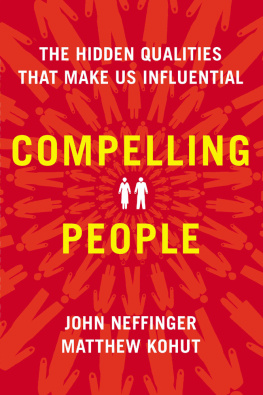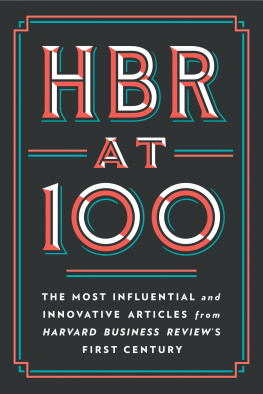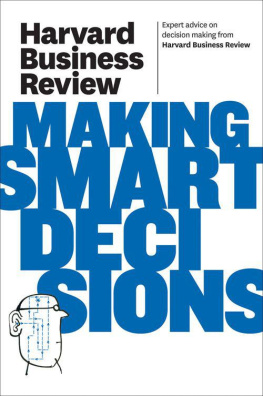Acknowledgments
T his book has been several years in the making at this point, and you would not be reading it without the efforts of many enthusiastic and talented people.
First among these is our agent, Mel Flashman, who had the foresight to realize the potential of these ideas and the patience to stick with us for the long haul. Megan Hustad has also been a co-conspirator since the proposal phase, gracing us with her insights and impeccable taste. Our editor, Caroline Sutton, at Hudson Street Press, has both believed in this project and helped focus it in ways that have made this a stronger book. And Kym Surridges judicious copyediting sharpened the text significantly.
The core ideas here were developed by reflecting on our work with our clients. We have learned so much from them, and are humbled by the trust they have placed in us over the years. Our business partner and friend Seth Pendleton, the P in KNP Communications, is the invisible presence throughout these pages. The concepts in the book grew out of our work together and our shared quest to develop a new approach to helping people deal with one another.
Two very special people, Ilyse Hogue and Betsy Kohut, supported us throughout, balancing strength and warmth as sharp readers and infinitely patient partners. We would not have made it without them. You are both owed many evenings, weekends, and vacations.
Amy Cuddy, of Harvard Business School, has been an invaluable friend and colleague. Having worked with her as thought partners and in the classroom for several years now, we are deeply grateful to her and proud to call her a collaborator and kindred spirit. Special thanks also to Todd Rogers, now at the Harvard Kennedy School, for instantly recognizing the connection between our work on strength and warmth and the research on warmth and competence, as well as for introducing us to Amy. Many experts have freely given their time to discuss their work with us. Tori Brescoll, Dana Carney, Tanzeem Choudhury, Susan Fiske, and Jessica Tracy all provided key insights about their research. And Jordan Pringle has helped to school us on style.
Many friends and colleagues weighed in with important insights, intellectual contributions, and encouragement, including Rich Benjamin, David Brock, Matt Butler, Carol Hedlund, Charlie Honig, Will Jenkins, Sally Kohn, Jean Lenihan, Cathey Park, Andrew Ranson, Sarah Rigdon, Rinku Sen, Gong Szeto, Barry Winer, Henry Winkler, and Chris Zinnow.
John is deeply grateful to his parents. Their wisdom is reflected throughout. This book would not be possible without the many lessons his parents taught, not to mention the serene confidence they showed in their only son as he walked away from the worlds of law and consulting to go his own way. John would also like to thank Sara Watts, nee OConnell, for helping him recognize and seize the opportunity in front of him.
Matt would like to thank Liz Coleman and the Center for the Advancement of Public Action at Bennington College, Donna Connell, Max Crandall, Samantha Dodge, and Haley Stephenson. And dating back long before this project, Andrew Kohut and Marybeth Kelman have provided endless encouragement and love.
The Big Idea
Strength
S trength gets things done. As a personal quality, strength is a measure of how much a person can impose their will on our world. People who project it command our attention, in part because we need to know if they are going to use their strength in ways that help us or in ways that harm us. Grudgingly or gladly, we respect people who project strength.
There is no shortage of examples of strong people in the public eye. Corporate downsizers Chainsaw Al Dunlap and General Electrics Neutron Jack Welch earned their reputations for strength pursuing efficiency above all and showing many workers the door in the process. Former British prime minister Margaret Thatcher cultivated her reputation as the Iron Lady. Supreme Court justice Antonin Scalia projects strength with his scornful wit and sneer.
When people seem weak, we are not as concerned with what they want, because they cannot make it happen anyway. We do not pay much attention to them unless we want something specific, and they generally have less to offer. Our personal ethical code may well dictate that we treasure them as our fellow human beings, but they lack the ability to affect our world. In that sense, they do not matter as much.
Leadership and strength are inextricably bound together. We look to strong people as leaders because they can protect us from threats to our group. Strength is essential to effective leadership, whether the organization is a submarine crew or a school clique.
Strength consists of two basic elements: the ability to affect the world, and the gumption to take action.
Ability
Ability includes anything that lets you affect the world. This encompasses qualities like your physical strength, learned technical skills, deft social skills, and hard-won wisdom. Social scientists refer to all of this together as competence.
People who accomplish a task that requires a high degree of practice, learning, or judgment command our attention and respect, whether they are brain surgeons or banjo players. These feats do not have to be showy: A top-notch accountant possesses formidable number-crunching acumen, which confers a certain standing among her colleagues.
Within an organization, you may be given the ability to command people to do things, or to hold them accountable if they refuse. Supervisory authority is a primary source of strength in organizational settings. (It is often bestowed on people who have proven themselves especially competent, but not always.)
In civilized company, some of the most critical abilities are social. A diplomat, for example, earns respect and authority by demonstrating mastery of social graces, using both verbal dexterity and a host of nonverbal cues. On the other hand, people who are less skilled at reading social cues or not adept at expressing themselves command less respect.
Social skills are not all about being charming. Getting ones way in social situationsor at least not getting trampledoften involves being assertive. A kid who responds to a mocking comment on the playground with a quick retort is not only less likely to get picked on next time but also more likely to be listened to when it is time to decide which game to play at recess. Delivering that retort swiftly involves the skill to come up with it on the fly, and it also involves something else: the will to stand up to the bully and risk the consequences.
Will
If having ability means you have the tools to make things happen, will is the strength of character it takes to act. Will manifests itself as a commitment to move forward, even (or especially) in the face of obstacles and resistance. We talk about this quality all the time, calling it determination, grit, motivation, ambition, perseverance, or resilience. Gandhi may have put it best: Strength does not come from physical capacity. It comes from an indomitable will. While we say both ability and will grant us strength, we salute Gandhis sentiment nonetheless.






